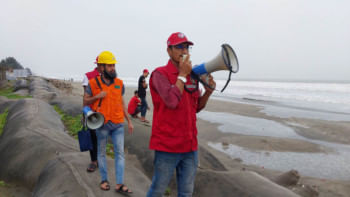Disaster risk finance is the way to go

In the face of a rapidly deteriorating climate situation, a framework or system that allows countries and developmental organisations to prepare funding in advance has become almost mandatory. It is largely seen that funding that is prepared after a disaster strikes is neither timely nor wholly successful.
A study conducted by the International Federation of Red Cross and Red Crescent Societies (IFRC) mentions that the number of people in need of humanitarian assistance due to climate disasters is projected to double to 200 million by 2050. Another study conducted by START Fund Bangladesh mentions that around 12.10 million people, belonging to some 2.71 million households, could potentially be affected by different climate-induced disasters such as monsoon floods, flash floods, river erosion, cyclones and landslides annually. Research has also found that a minimum of 18.33 million people may get exposed to climate-related hazards in all 64 districts of Bangladesh a year between 2021 and 2025.
Between 2000 and 2013, natural disasters cost Bangladesh more than $10 billion in economic losses. Available funding for relief, rehabilitation and reconstruction, however, stood at $2 billion only. Measuring the value of non-economic losses such as health hazards, losses to education, etc is more difficult; experts predict those losses to be valued at much higher.
Another study by Start Fund, spanning the last nine years, calculated that 1,053 lives were lost and 9.4 million people displaced during different climate-related disasters in 58 districts of the country since 2014. The existing finance mechanisms are not comprehensive or anticipatory in nature and create more barriers for vulnerable countries. Funds for climate-induced disasters are mostly raised at events, whereas disasters, when they strike, may not give responders enough time to arrange fundraisers to raise funds. They are neither sufficient nor efficient to deliver finances of the speed or scale necessary to respond to losses and damages. We need to shift the focus from response to protecting people ahead of shocks. Relying on pre-agreed plans and finance is a faster, more dignified and cost-effective approach to disaster and crisis.
The solution? Disaster risk financing. The concept is expected to reduce losses and damages associated with the sudden onset of climate disasters. The United Nations says that for every $1 invested in such a fund, $6 can be saved, with additional benefits of up to $4. Investing in climate resilience projects even creates jobs and saves money. Just a 24-hour warning before a storm or heatwave can curb ensuing damage by 30 percent. It was calculated that spending $800 million a year could translate into savings of $3-16 billion, with additional benefits of $66 billion annually.
The key actions should consider: i) investing in early warning systems and capacities to support anticipatory action; ii) investing in local capacities to disseminate and act on early warnings at the community level; and iii) investing in preparedness capacities at the local level to ensure actors are able to rapidly implement anticipatory actions.
Before one can truly conceive of an up-and-running anticipatory fund programme, there must be proper data analysis – reviewing history, consulting community wisdom, and identifying causes and concerns. Many organisations – i.e. IFRC, WFP, Friendship International, ADPC, etc – in Bangladesh and abroad are moving to create these models, through which it is possible to predict disasters, get central approvals taken prior to a disaster, and go for fund mobilisation on site as soon as the warning signals are visible. The more localised the model, the more acute the impact.
The model being proposed must include extensive scientific data, which lies dormant in files and folders most of the time. Utilising it, analysing and interpreting it, bringing it to the forefront of the disaster, and designing programmes around it are crucial to building these models. Rather than waiting for aid to come through, low- and middle-income nations need to gradually come out of disaster risk management and ensure that budget allocations at each level include anticipatory funding instead.
A significant benefit of such a research-based climate awareness and disaster finance model is a stellar early warning system, interpreted differently for different locations. The wider the area it covers in terms of safeguarding people and their livelihoods prior to a disaster, the more successful it would be considered. This could also help spur local action, catalysing a proactive approach in the local people to safeguard themselves. The beauty of such models is also that these can be developed remotely, by young people and those that have the technological know-how to do this.
Governments, development partners, the private sector and civil society should all come together through COP28 and UN-GPDRR 2024 to co-create such efficient and accountable mechanisms that would keep communities on the frontline, considering loss and damage impacts. Engaging transboundary facilitators and partners like Global Network on Disaster Reduction (GNDR) and Climate Action Network (CAN) can also work synergistically if certain disasters are common in a few neighbouring countries. This would give the issue both national and international traction.
Kazi Amdadul Hoque is a climate, development, and humanitarian activist. His Twitter handle is @KaziAmdadbd. He can be reached at [email protected]

 For all latest news, follow The Daily Star's Google News channel.
For all latest news, follow The Daily Star's Google News channel. 











Comments